Car AC compressor
What is a car AC compressor?
A car AC compressor is used to convert low pressure refrigerant gas 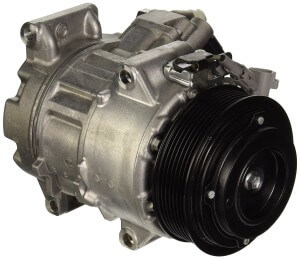 into high pressure gas. The AC compressor is driven by a drive belt connected to the crankshaft in non-hybrid vehicle and by an electric motor in many hybrid cars.
into high pressure gas. The AC compressor is driven by a drive belt connected to the crankshaft in non-hybrid vehicle and by an electric motor in many hybrid cars.
In a non-hybrid engine, the drive belt rotates the car AC compressor pulley any time the engine is running. But the pulley only operates the AC compressor when the driver requests AC. At that point, the HVAC control system activates a magnetic clutch assembly to connect the AC pulley to the AC compressor drive shaft. The drive shaft then moves the pistons inside the compressor to draw in and compress the refrigerant.
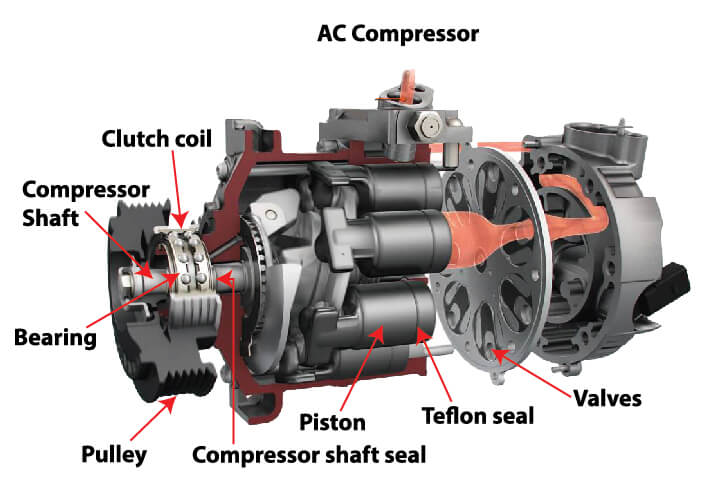
AC compressor pistons and cylinders are similar in some ways to engine pistons and cylinders. However, instead of having metal piston rings to seal against the sides of the cylinder, AC compressor piston seals are made from Teflon. Since refrigerant gas alone can’t lubricate the Teflon piston seals, car AC systems require a special refrigerant oil.
How does a car AC compressor fail?
Refrigerant leaks cause the most damage
Before a car AC system is filled at the factory, air and humidity are removed by applying a vacuum to the entire system. Then the refrigerant and lubricating oil are added. If the system develops a leak and outside air enters the system, the moisture in that air combines with the refrigerant and oil to form acids that degrade all the components in the AC system. The acid corrodes metal parts, reduces the lubricating efficiency of the oil and causes accelerated wear on all moving parts.
To combat acid formation, car AC systems include either a receiver/dryer or accumulator. Both components contain desiccant to absorb and retain moisture within the system. But once the desiccant becomes saturated, any additional moisture entering the system will contribute to acid formation.
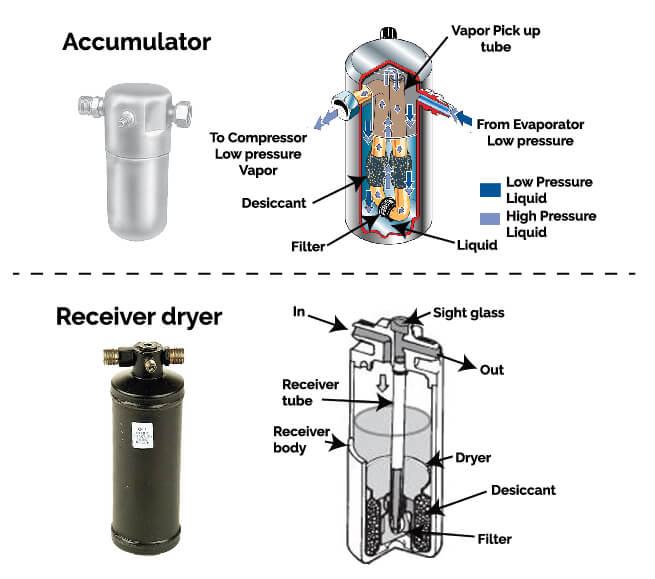
AC system leaks can occur when connecting joints expand and contract during weather extremes, when main seal and sealing O-rings age and shrink, or when AC hoses or gaskets deteriorate and leak. 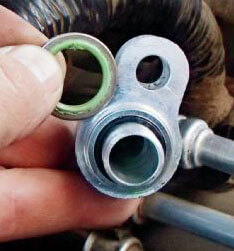 Simply refilling the system doesn’t negate the negative effects of the moisture inside the system.
Simply refilling the system doesn’t negate the negative effects of the moisture inside the system.
Over time the acid and oil breakdown and overall lack of lubrication cause the cylinders and pistons to wear, and the worn metal particles spread throughout the AC system. The combination of acid, degraded oil and worn metal is referred to as Black Death because of the black sludge that accumulates in the evaporator and condenser coils and all AC hoses. In some cases, the technician can flush the sludge from the lines and coils. But in other cases, all AC components must be replaced, costing upwards of $2,000.
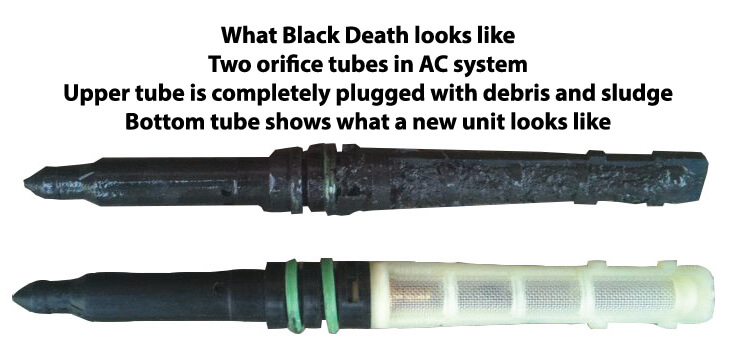
Oil starvation also causes AC compressor failure
As car AC systems lose refrigerant and are recharged, many DIYers and some technicians fail to replace the lost oil, resulting in a lack of lubrication.
Compressor shaft seal leaks cause compressor failure
The point where the compressor shaft enter the compressor body is 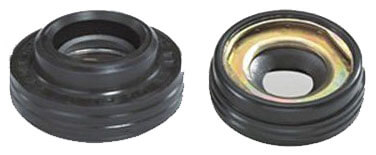 prone to leaks due to wear on the compressor shaft seal. One indication of compressor shaft seal failure is the presence of oil on the clutch and a pattern of oil flung onto the underside of the car’s hood. This is caused by refrigerant and oil leaking past the compressor shaft seal and reaching the pulley, which then flings it in an arc under the hood.
prone to leaks due to wear on the compressor shaft seal. One indication of compressor shaft seal failure is the presence of oil on the clutch and a pattern of oil flung onto the underside of the car’s hood. This is caused by refrigerant and oil leaking past the compressor shaft seal and reaching the pulley, which then flings it in an arc under the hood.
AC compressor repair
In the past, repair shops replaced compressor shaft seals or rebuilt the compressor. But with the skyrocketing labor costs, it’s now longer feasible to rebuilt car AC compressors on-site. Most shops replace the AC compressor with a new unit or a rebuilt version from their auto parts supplier.
Car AC compressor cost
AC compressor replacement involves evacuating the entire AC system, performing a thorough flush to remove any sludge or debris and then proceeding with parts replacement. The accumulator or receiver drier must be replaced, along with all gaskets and O-rings throughout the system. Even if a hose connection isn’t leaking, it’s best to replace the seals and O-rings now to pre-empt future failures.
Next, the shop installs a filter to capture any debris that remains after flushing. Then the shop adds the proper amount of refrigerant oil to the system and installs the new magnetic clutch, pulley and compressor. The technician then applies a vacuum to the system for at least 45-mins. to remove all air and moisture before adding refrigerant.
Once the system is recharged, the technician performs a leak check and a performance test to ensure that all components are operating properly.
Depending on the year, make, model and engine car AC compressor replacement cost can range from as low as $600 to an average cost of around $1,500.
©, 2017 Rick Muscoplat
Posted on by Rick Muscoplat
